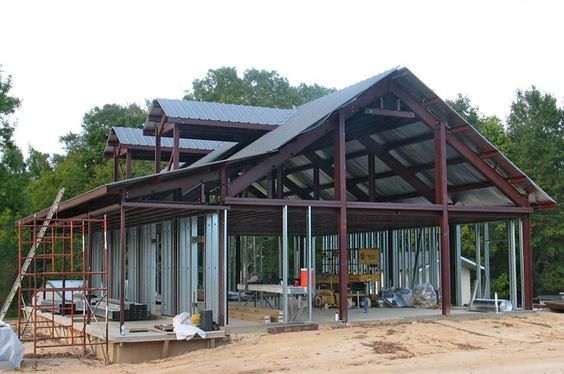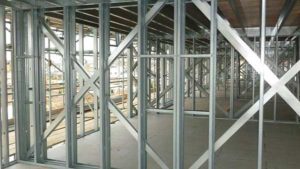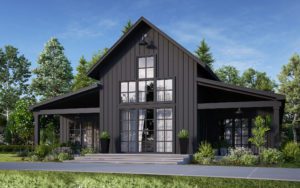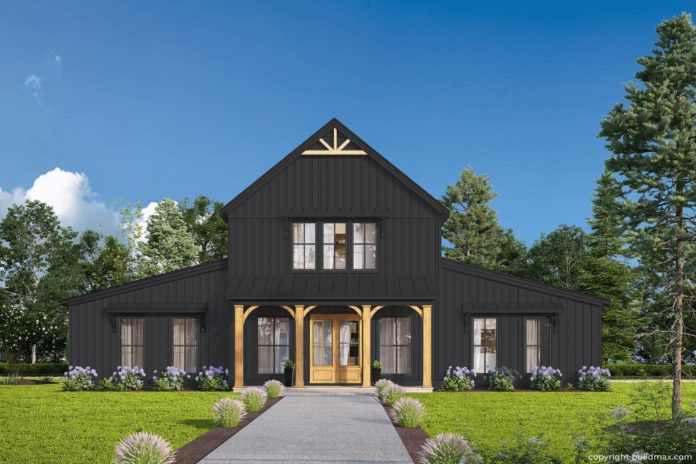The advent of steel-framed buildings marked a revolutionary turning point in the construction industry, with its roots tracing back to the iconic Home Insurance building in Chicago, Illinois. This magnificent skyscraper, erected in 1885, stands as a testament to innovation, as it was the first structure of its kind to boast an all-steel skeleton frame. The audacious decision to utilize steel as the primary building material quickly yielded remarkable results, as the structure showcased unparalleled rigidity and durability, even in the face of the formidable winds that famously sweep through Chicago, earning the city its moniker, “the windy city.”
The influence of this pioneering steel construction swiftly transcended Chicago’s boundaries, spreading its impact across the globe. Today, the legacy of steel frame construction endures, manifesting itself in diverse forms, with personal favorites including the modern marvels of barndominiums, shop houses, and metal buildings. Undoubtedly, steel frame construction has become deeply entrenched within the commercial construction landscape, celebrated for its unwavering strength and resilience that have withstood the test of time.
However, as you embark on your construction journey, the pivotal question arises: Is steel the right choice for your project? In a market teeming with an array of building materials, does steel outshine wood or structural concrete as the superior option? What factors set one apart as the optimal choice over the others? The decision regarding the ideal building material is not one to be taken lightly, and in the pages that follow, we shall explore the nuances that distinguish steel frame construction from its counterparts, offering you valuable insights to aid in making a well-informed choice for your unique endeavor.

Strength is an integral hallmark of structural steel, underpinned by a meticulous adherence to stringent technical specifications. To ensure the long-lasting integrity of steel structures, such as the crucial steel I-beams and supporting trusses, an unwavering commitment to precision has been embraced. This dedication has allowed structural steel to shine with remarkable strength and durability, capable of enduring for generations. The secret behind this lies in the superb strength-to-weight ratio that steel offers compared to other common building materials.
The evolution of structural steel’s strength has been achieved through the gradual introduction and integration of ultra-high carbon steels and high-strength, low-alloy metals into the construction market. Different grades and types of steel are judiciously selected for various components of the building, categorized based on the strength-to-weight ratio exhibited by the metal. In the construction realm, it’s a wise strategy to err on the side of over-engineering support structures, ensuring their steadfastness under the weight of time and environmental forces.
Specifically, this quality is often referred to as the steel’s “specific strength,” which essentially quantifies how much weight it can effectively support. The use of quenched and tempered steel alloy further enhances the robustness of I-beams, a primary support component in steel frame homes. As these beams bear a significant share of the stress and weight of the structure, their strength-to-weight ratio proves exceptionally favorable.
It’s noteworthy that some of these beams are even hollow, further optimizing their weight-bearing capacity. The classification of construction materials into categories based on specific strength or strength-to-weight ratio is a common practice. This metric is calculated by dividing a material’s strength by its density, providing insights into how effectively steel performs in relation to its weight and cost. In essence, structural steel’s exceptional strength attributes, exemplified by its superior specific strength, make it a highly desirable choice for construction projects, ensuring not only structural integrity but also long-term cost-efficiency.
Efficiency is a great reason to go with steel-framed construction over wood. If you have ever been on a stick-built construction site, you’re all too aware of the amount of waste that occurs when building with wood. Every piece has to be precisely measured and cut according to the specifications laid out in your barndominium house plans; they act as an instruction manual for the builder to follow so your house is up to code when it’s finished. With a standard steel frame construction build, the process is substantially different. First, the I-beams and any metal framing components have been fabricated to the exact size and shape specific to the job and are either bolted or welded together on-site as soon as it’s delivered. No cutting or modification is required and steel buildings can be erected in a fraction of the time it takes to frame a stick-built home. The beams being delivered to the build site are already prepped, measured, and ready to install. This leaves steel frame construction sites less cluttered, safer, and way more efficient than wood.

Insulation stands as a pivotal consideration for many individuals contemplating steel construction. When it comes to metal buildings, insulation plays a critical role in preventing the exchange of heat and cold, impeding the infiltration of wind, dampening the cacophony of rain and hail on the roof, and averting condensation, which can lead to rust and compromise the structural integrity of steel.
While it’s true that steel possesses certain characteristics that might appear less favorable compared to wood, such as its relatively lower insulating capacity, it’s important not to be dissuaded from harnessing the myriad benefits of this exceptional material. Though wood boasts an impressive 400% higher heat insulation capability than steel, there exist straightforward measures to ensure that steel structures are effectively insulated.
Given steel’s rapid heat conductivity, one effective approach is to envelop the steel beams in foam insulation. This seemingly simple step can fortify your barndominium against the most challenging weather conditions, mitigating the temperature fluctuations that might otherwise affect the comfort and energy efficiency of your living space. Thus, with thoughtful insulation solutions in place, steel construction remains a viable and advantageous choice, offering a robust combination of structural strength and weather-resistant properties.

Fire and corrosion-resistant materials are indeed rare finds, but steel, in conjunction with reinforced concrete, stands out as a formidable choice in this regard. Steel, as a building material, contributes significantly to fire resistance through the application of fireproofing materials. This attribute holds particular importance, especially during the construction phase when materials are scattered about, and the risk of fires is elevated.
Steel’s susceptibility to corrosion, particularly in humid, wet, or saline environments, is a known concern. However, with proactive measures in insulation and protective coatings, these issues can be effectively mitigated. Thoughtful insulation strategies can create a barrier that shields steel from the corrosive effects of moisture and salt, ensuring its long-term durability.
One of the distinctive features of steel-framed structures lies in how they distribute the structural load to the foundation. Unlike load-bearing construction, where the weight of the building rests primarily on its walls, steel structures allocate the load across steel beams and columns. These elements then transmit the load directly to the foundation. This unique load distribution mechanism not only imparts greater strength to the structure but also relieves the walls from bearing the brunt of the weight, leading to a more resilient and robust overall construction. In essence, steel construction offers a compelling combination of fire resistance, corrosion protection, and structural efficiency, making it a standout choice in the realm of building materials.
.

The cost of steel, relative to other construction materials, is subject to a myriad of factors, with geographic location and market availability playing pivotal roles. Just as the price of oil experiences fluctuations, building material costs exhibit similar dynamics. Moreover, the cost of delivering steel can be influenced by fuel prices, as these materials often require transport on oversized flatbed trucks, which is a contributing factor in the growing popularity of structurally reinforced concrete.
Yet, steel, proverbially, “packs a punch” when it comes to offering optimal value for your investment. Structural steel boasts conspicuously superior strength compared to the majority of alternative building materials available today. As we’ve delved into previously, steel’s efficiency in construction, the precision in the design and measurement of beams prior to delivery, minimizes the need for cutting or extensive adjustments on-site. Instead, it involves the precise assembly of pre-fabricated beams and structural components, resulting in minimal waste and labor costs.
This efficiency not only keeps costs in check but also positions steel competitively alongside other construction materials, such as wood and reinforced concrete, in terms of overall expense. Thus, while the price of steel may fluctuate due to market conditions and delivery considerations, its inherent strength and cost-efficiency render it a compelling choice for those seeking durability, reliability, and value in their construction projects.

As we’ve meticulously demonstrated, structural steel construction stands as an exceptional alternative to traditional wood framing and represents a formidable competitor to other materials like concrete. If you share the common aspiration of erecting a steel-framed barndominium, your primary concern naturally revolves around creating a structure that is not only supremely sturdy and resilient but also cost-effective, ensuring its enduring presence for years to come.
When you follow the appropriate measures to shield steel from the elements and uphold unwavering standards of material quality from the project’s inception, you can rest assured that your steel-framed barndominium will not only shine but also excel in every conceivable aspect. In fact, it’s safe to say that your steel-framed barndominium is virtually guaranteed to outlast and outperform every wood-framed residence in the vicinity. The factor of longevity alone places steel-framed barndominiums head and shoulders above structures constructed with other building materials.
To assert that steel is merely a superior building material would be a significant understatement. It is, in essence, the epitome of structural support and integrity. So, as we draw this discourse to a close, allow me to leave you with a straightforward question that encapsulates the essence of our discussion: Why entertain the notion of using an inferior material when it comes to the structural fortitude and integrity of your dream barndominium? Steel’s undeniable attributes position it as the logical and unrivaled choice for those who demand nothing less than excellence for their cherished construction projects.










